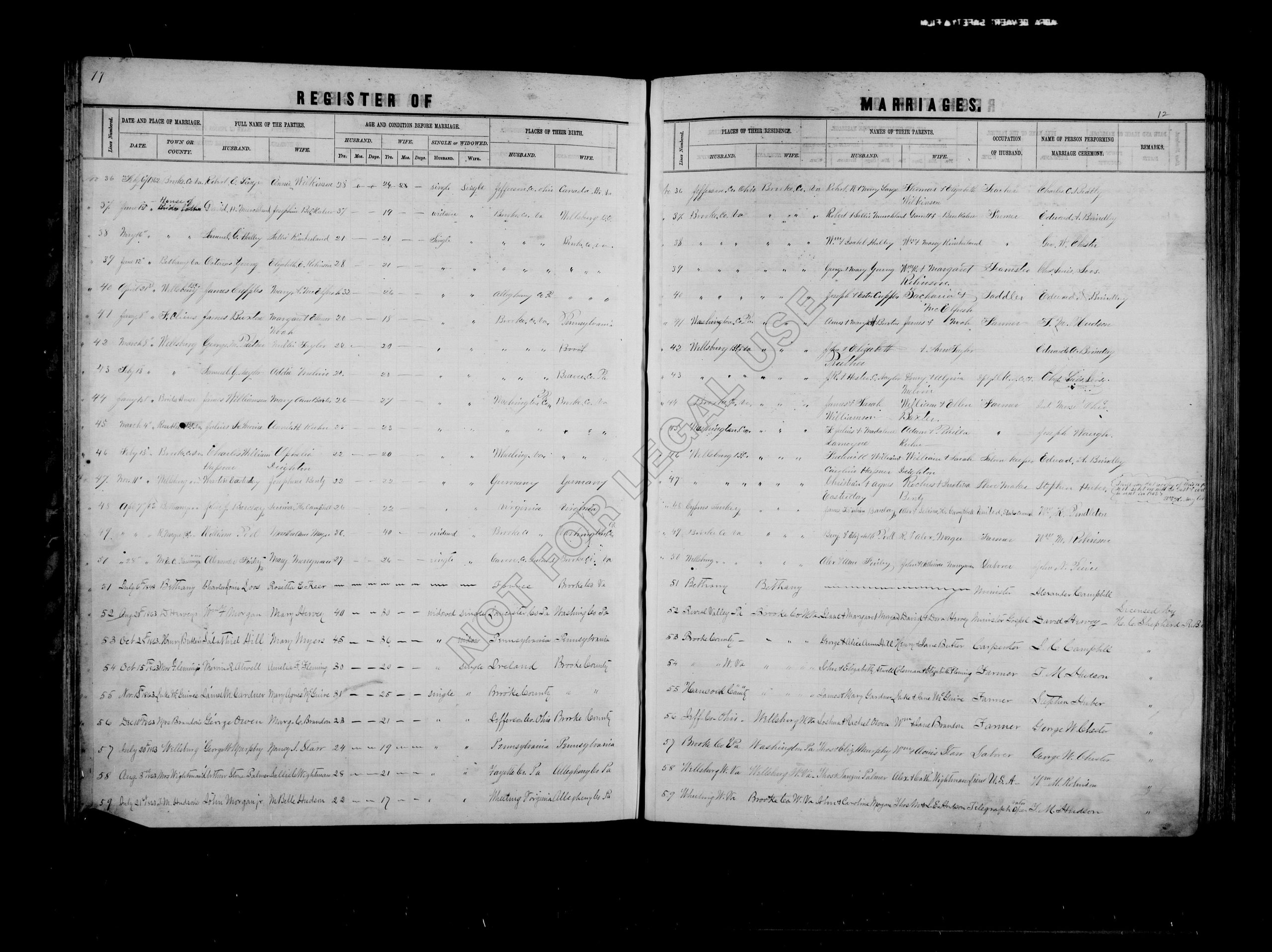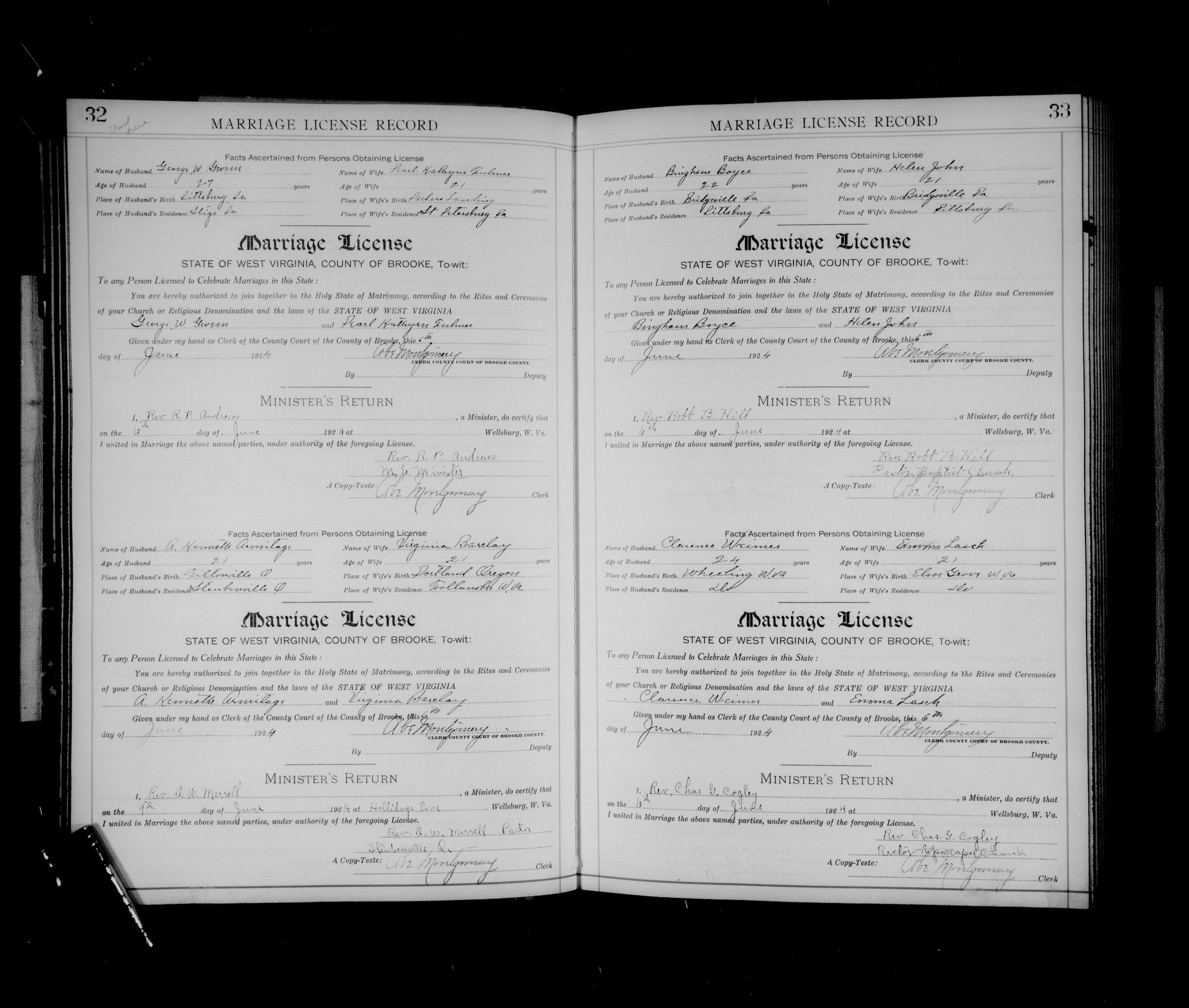Vital records, including birth, death, and marriage certificates, are considered “the milestones of life and the backbone of genealogy.” As such, it makes sense to begin our genealogical search in earnest here. As stated in the first part of our mini-series, these articles will focus on genealogical resources specific to Wheeling, the Ohio Valley, and West Virginia as a whole.
Birth Records
Under Virginia law, counties were required to record births and deaths and this practice continued when West Virginia was granted statehood. Vital records have been recorded in Virginia/West Virginia since 1853. Some counties have records dating back even further, depending on the county’s inception. For instance, Ohio County, one of the oldest counties in the state, has vital records dating back to 1776. The good news for the genealogist is that vital records are recorded on a county level and no Virginia/West Virginia counties were divided after the Civil War.
Though birth records make up part of the backbone of genealogy they are (alas!) often the most difficult vital record to find. Part of this is due to confidentiality: birth records are not made “open access” until they are older than 100 years. To find birth records that meet this criterion, one of the best resources is WVCulture.org. Powered by the West Virginia Department of Arts, Culture and History, this website allows you to search birth, death, and marriage records by county. The page also gives a summary of records available broken down by county and year and the website has several supplementary documents about genealogical research in general (see additional resources section).
If you don’t find what you need here, or if you are simply partial to printed resources, I also strongly recommend checking out the Wheeling Room at the Ohio County Public Library. Don’t be misled by the name of the room, though—the Wheeling Room has records for West Virginia counties and several from counties in Ohio and Pennsylvania, as well.
If you really need or want a birth record less than 100 years old, they can be obtained…for a price. For more information on how to request a record, visit the Health Statistics Center, a subset of the WV Department of Health and Human Resources.
Death Records
Like birth records, death records have been kept by individual counties since 1853 or the county’s creation. Death records become available when the record is older than 50 years. Again, one of the best resources is WVCulture.org. These records are also available through the Ohio County Public Library’s Wheeling Room.
Other types of resources to consider include funeral home records, cemetery record books, and obituaries and death notices. The Wheeling Room has several printed resources for local funeral homes and cemeteries, as well as a collection of obituaries/death notices of Ohio Valley residents from a variety of local newspapers. For more information about these, please check out the “Additional Resources” section at the end of the article.
As with birth records, death records that are not yet “open access” can be obtained for a fee. Here as well researchers can visit the Health Statistics Center.
Though it is not West Virginia-specific, I would be remiss if I did not mention a wonderful free source called FindAGrave.com. This is a crowdsourced project that aims to allow users to find and deposit information about the person behind the headstone. Family members or anyone who knew the individual can add biographical information, links to relatives’ graves, and photos. Here is an example of the Find A Grave page for Zona Heaster Shue, aka the Greenbrier Ghost.
Marriage Records
Marriage records, like death records, become available when the record is older than 50 years. Like other vital records, marriage records can be found through WVCulture.org as well as in print format at the Ohio County Public Library.
Due to the standardization of forms in 1917, vital records, including marriage records, are going to look different depending on when they were created. For an idea of what information can be found in marriage records during different time periods, consider this one from 1863 between Decima H. Campbell (daughter of church reformer Alexander Campbell) and John J. Barclay, and a 1924 record between one of Decima’s descendants, Virginia Barclay, and her husband A. Kenneth Armitage.
One can see that pre-1917 marriage records were recorded in ledgers and typically included information such as the spouses’ names, ages, place of marriage, marital status (single or widowed), birthplaces, place of residence, name of parents, occupation of husband, and name of the person who performed the marriage ceremony. Later records are typically sparser and include only the couple’s names, ages, places of birth, places of residence, as well as some information from the clerk’s office and presiding minister (if applicable).
Helpful Tips
As you begin your search, there are several things to bear in mind:
1. Look for records at the county rather than the state level. Statewide indexes did not exist in West Virginia prior to 1917 when it became a requirement for counties to send vital records to the West Virginia Department of Health Vital Registration office.
2. If you don’t find an ancestor in the “expected” county, widen your search into adjacent counties.
3. Don’t dismiss a record out of hand if it doesn’t match exactly: sometimes birth certificates (unfortunately for the genealogist!) were issued before the baby was even named. If you think you have found the birth certificate for an ancestor, cross-reference it with a local newspaper: there may be a birth announcement with the person’s name, place and date of birth, and their parents. This goes for death and marriage records as well: if you cannot find the vital record, you may be able to glean information from an obituary or wedding announcement.
4. When using WVCulture.org, be sure to open the images that come up with a search result. The landing page for a search rarely contains a full transcription of the information contained within the record being consulted. If you only go by what is included on a vital record’s detail page, you will be missing out on a great deal of information.
Though these records are the “backbone” of genealogy, don’t despair if you have trouble locating vital records for your ancestors. There are plenty of other resources one can consult, including the census, which we will cover next week. Until then, happy researching!
Click here for part 3 or part 4.
• Raised in Wellsburg, West Virginia, Anna Cipoletti is a proud alumna of Mount de Chantal Visitation Academy, West Liberty University and Kent State University. She received a Bachelor of Arts in English Literature from West Liberty in 2014 and a Master of Library and Information Science degree from Kent State in 2017. Anna has made a career out of a lifelong love of books and works full-time at Bethany College as a librarian and parttime as a bookseller and book reviewer. She resides in Beech Bottom with her sister and two Siamese cats. A nature enthusiast, Anna often spends her free time visiting one of West Virginia’s many beautiful parks or kayaking along Buffalo Creek.
References
“Archives and Special Collections.” Ohio County Public Library, https://www.ohiocountylibrary.org/archives/archives-and-special-collections/4961
Greenwood, Val D. The Researcher’s Guide to American Genealogy, 3rd ed., Genealogical Publishing, 2000.
Henderson, Mary Lou. Foster/Reasner Funeral Home records, 1996.
“Local History Collection Development Policy.” Ohio County Public Library, https://www.ohiocountylibrary.org/more/local-history-collection-development-policy-(archival-policy)/5028
McCombs, Cheryl Ann Krupica. Various Obituaries & Death Notices of Ohio Valley Residents and Natives Spanning the Years 1852-2000, Cheryl Krupica, 2001.
Mount Zion Cemetery Association. Record book, Mt. Zion Cemetery Association, 1919-1943.
“Project Summary and Update.” West Virginia Vital Research Records, West Virginia Department of Arts, Culture and History, http://www.wvculture.org/vrr/vrrhandout.html
Scouras, Susan. “West Virginia Vital Research Records Project Online: Searchable Database and Digital Images of Selected Birth, Death and Marriage Records.” Originally published in West Virginia Archives and History News, vol. 10, no. 9, Nov. 2009 and last revised online June 2017. http://www.wvculture.org/history/archives/vitalrecordsarticle.pdf
“Vital Records in West Virginia: Deaths.” West Virginia Archives and History News, vol. 8, no. 7, Sept. 2007. http://www.wvculture.org/history/ahnews/0907news.pdf
“Vital Records in West Virginia: Births.” West Virginia Archives and History News, vol. 8, no. 8, Oct. 2007. http://www.wvculture.org/history/ahnews/1007news.pdf
“Vital Records in West Virginia: Marriages.” West Virginia Archives and History News, vol. 8, no. 9, Nov. 2007. http://www.wvculture.org/history/ahnews/1107news.pdf
“Vital Registration’s Genealogy Information.” West Virginia Health Statistics Center Genealogy Page, West Virginia Department of Health & Human Resources, https://www.wvdhhr.org/bph/hsc/vital/Genealogy.asp
“Vital Research Records Search Selection.” West Virginia Vital Research Records, West Virginia Department of Arts, Culture and History, http://www.wvculture.org/vrr/va_select.aspx





